Nephrotic syndrome. What is new since the 1988 study?.
DOI:
https://doi.org/10.20344/amp.2306Abstract
The authors make a retrospective review of 53 new cases of Nephrotic Syndrome followed up in the Nephrology Unit from November 1988 to March 1994, bearing in mind the evaluation of casual changes of the disease standard regarding a previous study of 1988. Epidemiological, clinical, therapeutical and evolutional aspects were studied. Forty-four cases of primary Nephrotic Syndrome (83%) were identified, 61.4% of which behaved as cortico-sensitive, 25% as cortico-dependent, and 13.6% as cortico-resistant; 8 cases (15%) of Nephrotic Syndrome secondary to infection, Systemic Lupus Erythematosus and Amyloidosis, and 1 case of congenital Nephrotic Syndrome (2%). The theory that the high number of cortico-dependent is, probably, related with a higher severity in the relapse diagnosis and/or changes in the children's standard of living is admissible. It was also observed that at present there is a lower number of hospital discharges, related to more careful attitudes adopted regarding the evolution of the disease.Downloads
Downloads
How to Cite
Issue
Section
License
All the articles published in the AMP are open access and comply with the requirements of funding agencies or academic institutions. The AMP is governed by the terms of the Creative Commons ‘Attribution – Non-Commercial Use - (CC-BY-NC)’ license, regarding the use by third parties.
It is the author’s responsibility to obtain approval for the reproduction of figures, tables, etc. from other publications.
Upon acceptance of an article for publication, the authors will be asked to complete the ICMJE “Copyright Liability and Copyright Sharing Statement “(http://www.actamedicaportuguesa.com/info/AMP-NormasPublicacao.pdf) and the “Declaration of Potential Conflicts of Interest” (http:// www.icmje.org/conflicts-of-interest). An e-mail will be sent to the corresponding author to acknowledge receipt of the manuscript.
After publication, the authors are authorised to make their articles available in repositories of their institutions of origin, as long as they always mention where they were published and according to the Creative Commons license.









